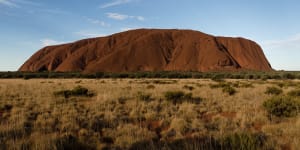I have felt it. And when I do,it is always followed by a feeling of sorrow.
I feel sorrow because to look at these special places,it is obvious what a wonderfully happy life my people lived before the First Fleet arrived with its deadly cargo of settlers on January 26,1788.

The answer to what should be done about January 26 can be found in a key proposal in the Uluru Statement from the Heart.James Brickwood
Over millennia,my people learnt to live with the land – how to move with her seasons rather than claw at her skin and poison her in defiance. My people had developed practices and laws for sustainability. We ensured we never outgrew and displaced other living things,because all living things had a place: the land and the plants and the animals were us and we would become them – our totems and our teachers. In our laws,we didn’t own the land as much as the land owned us. And,we were masters of dispute resolution. Take the Yolngu process of Makarrata in which people come together in a closer relationship after a struggle.
The First Nations of this continent had advanced societies,an abundance of sustenance – we had peace until January 26,1788.
It is a crying shame that Governor Arthur Phillip did not have the humanity to negotiate the British settlement with First Nations people,rather than commence a brutal invasion:the herding of families and forcing them off cliffs;the thrashing our babies’ heads against rocks;the poisoning of our waterholes and blankets;the dispossessing us of our homelands,our shelter,our food and water sources;the enslavement and keeping our wages;the destruction of our most sacred and ancient of places;the forced assimilation and taking our children – it all began on January 26,1788. January 26 is the date that marks the end of over 60 millennia of comparative peace.
Over the years,I’ve written on several occasions about how wrong it is to celebrate nationhood on January 26. Other First Nations activists have written more. I have organised,marched and spoken at events – the angry rallies,the reflective remembrances,the sorrowful mournings – and generally joined a chorus of Australians,both Indigenous and non-Indigenous,to decry the celebration of our identity on the anniversary of our invasion. The chorus of solidarity with First Nations people is growing. But what seems to be missing from the debate is how we will determine the solution.
The ideas are many. Some say May 8 because it sounds like “mate”. Some say January 25,the eve of invasion when our country was still at peace. Another is January 1,the commencement of Federation – do the people who suggested this realise that genocide continued well in to the 20th century? And others want the date abolished altogether. Who could possibly decide?
Ultimately,the authority to decide is with the federal government. But it would be wrong,or at least doomed to fail,if the government decided alone. There should not be a decision about Australia Day on January 26 without the people who are most affected by it:First Nations people.
The government could do what they usually do:they could choose a few Blackfellas,whoever is the flavour of the day,and ask them what date they would choose before making the decision themselves based on what may win the most votes anyway. Or,the government may do a national survey or plebiscite,but again,like in this democracy overall,First Nations people would be practically voiceless in the decision,because we are merely 3 per cent of the population.
The answer to the Australia Day debate – exactly how we finally decide to mature as a nation and stop celebrating genocide – is already with government. They do not need to decide alone,nor with just a few hand-picked Indigenous people. The solution is recommended in numerous reports already:The Referendum Council,the Joint Select Committee on Constitutional Recognition relating to Aboriginal and Torres Strait Islander People and the Indigenous Voice Co-Design. Each of these reports to government has recommended that they take notice of the key proposal in the Uluru Statement from the Heart:constitutional enshrinement of a First Nations Voice to Parliament.
A constitutionally enshrined Voice is the answer to the question of Australia’s identity – how we mature as a nation –and how we should celebrate it. By amending the Australian constitution to include First Nations Voices,we will be including 60,000 years of continuous culture in what constitutes us as Australians. And further,when we have established a First Nations representative body,the Voice,Aboriginal and Torres Strait Islander people will have gained the ability to choose our own representatives,constitutionally guaranteeing us the ability to have the discussion with the Australian people,in a proper way,about when and how we should celebrate.
A future Australia Day could be on the date a successful Voice referendum – the day Aboriginal and Torres Strait Islander people are finally heard.